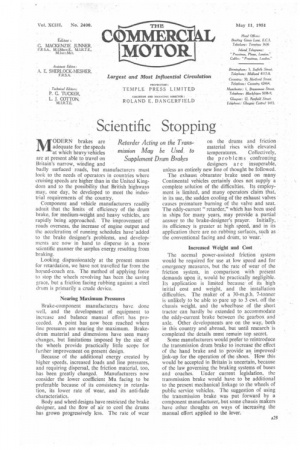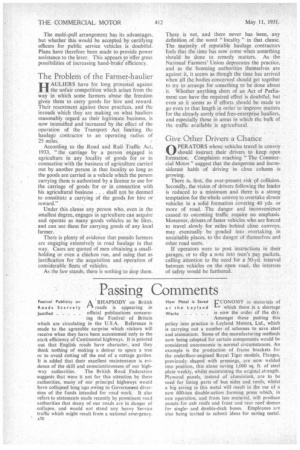Scientific Stopping
Page 31

Page 32

If you've noticed an error in this article please click here to report it so we can fix it.
MODERN brakes are adequate for the speeds at which heavy vehicles are at present able to travel on Britain's narrow, winding and badly surfaced roads, but manufacturers must look to the needs of operators in countries where cruising speeds are higher than in the United Kingdom and to the possibility that British highways may, one day, be developed to meet the industrial requirements of the country.
Component and vehicle manufacturers readily admit that the limits of efficiency of the drum brake, for medium-weight and heavy vehicles, are rapidly being approached. The improvement of roads overseas, the increase of engine output and the acceleration of running schedules have"added to the brake designer's problems, and developments arc now in hand to disperse in a more scientific manner the surplus energy resulting from braking.
Looking dispassionately at the present means for retardation, we have not travelled far from the horsed-coach era. The method of applying force to stop the wheels revolving has been the 'saving grace, but a friction facing rubbing against a steel drum is primarily a crude device.
Nearing Maximum Pressures Brake-component manufacturers have done well, and the development of equipment to increase and balance manual effort has proceeded. A point has now been reached where hoe pressures are nearing the maximum. Brakedrum material and dimensions have seen many changes, but limitations imposed by the size of the wheels provide practically, little scope for further improvement on present design.
Because of the additional energy created by higher speeds, increased loads and line pressures, and requiring dispersal, the friction material, too, has been greatly changed. Manufacturers now consider the lower coefficient Mu facing to be preferable because of its consistency in retardation, its lower rate of wear, and its anti-fade characteristics.
Body and wheel designs have restricted the brake designer, and the flow of air to cool the drums has grown progressively less. The rate of wear on the drums and friction material rises with elevated temperatures. Collectively, the problems confrontingdesigners a r e insuperable, unless an entirely new line of thought be followed. The exhaust obturator brake used on many Continental vehicles certainly does not supply a complete solution of the difficulties. Its employment is limited, and many operators claim that, in its use, the sudden cooling of the exhaust valves causes premature burning of the valve and seat. The eddy-current "retarder." which has been used in ships for many years, may ,provide a partial answer to the brake-designer's prayer. Initially, its efficiency is greater at high speed, and in its application there are no, rubbing surfaces, such as the conventional facing and drum, to Wear..
Increased Weight and Cost The normal power-assisted friction system would be required for use at low speed and for emergency measures, but the rate of wear of the friction system, in comparison with present demands upon it, would be practically negligible. Its application is limited because of its high initial cost and weight, and the installation difficulties. The maker of a 30-m.p.h. 7-tonner is unlikely to be able to pare up to 3 cwt. off the chassis weight, and the wheelbase of the short tractor can hardly be extended to accommodate the eddy-current brake between the gearbox and axle. Other developments are on the way, both in this country and abroad, but until research is completed the details must remain top secret.
Some manufacturers would prefer to reintroduce the transmission drum brake to increase the effect of the hand brake and to pfovide an improved' link-up for the operation of the shoes. How this would be accepted in Britain is uncertain, because of the law governing the braking systems of buses and coaches. Under current legislation, the transmission brake would have to be additional to the present mechanical linkage to the wheels of public service vehicles. The suggestion of using the transmission brake was put forward by a component manufacturer, but some chassis makers have other thoughts on ways of increasing the manual effort applied to the lever. The multi-pull arrangement has its advantages. but whether this would be accepted by certifying officers for public service vehicles is doubtful. Plans have therefore been made to provide power assistance to the lever. This appears to offer great possibilities of increasing hand-brake efficiency.
The Problem of the Farmer-haulier HAULlERS have for long protested against the unfair competition which arises from the way in which some farmers abuse the freedom given them to carry goods for hire and reward. Their resentment against these practices, and the inroads which they are making on what hauliers reasonably regard as their legitimate business, is now intensified and increased by the effect of the operation of the Transport Act limiting the haulage contractor to an operating radius of 25 miles. According to the Road and Rail Traffic Act, 1933, "the carriage by a person engaged in agriculture in any locality of goods for or in connection with the business of agriculture carried out by another person in that locality so long as the goods are carried in a vehicle which the person carrying them is authorized by a licence to use for the carriage of goods for or in connection with his agricultural business . . . shall not be deemed to constitute a carrying of the goods for hire or reward." Under this clause any person who, even in the smallest degree, engages in agriculture can acquire and operate as many goods vehicles as he likes, and can use them for carrying goods of any local farmer. Thefe is plenty of evidence that pseudo farmers are engaging extensively in road haulage in that way. Cases are quoted of men obtaining a smallholding or even a chicken run, and using that as justification for the acquisition and operation of considerable fleets of vehicles. As the law stands. there is nothing to stop them. There is not, and there never has been, any definition of the word " locality " in that clause. The majority of reputable haulage contractors feels that the time has now come when something should be done to remedy matters. As the National Farmers' Union deprecates the practice, and as the licensing authorities themselves are against it, it seems as though the time has arrived when all the bodies concerned should get together to try to arrange for something to be done about it. Whether anything short of an Act of Parliament can have the required effect is doubtful, but even so it seems as if efforts should be made to go even to that length in order to improve matters for the already sorely tried free-enterprise hauliers, and especially those in areas in which the bulk of the traffic available is agricultural.
Give Other Drivers a Chance PERATORS whose vehicles travel in convoy should instruct their drivers to keep open formation. Complaints reaching "The Commercial Motor" suggest that the dangerous and inconsiderate habit of driving in close column is growing. There is, first, the ever-present risk of collision. Secondly, the vision of drivers following the leader is reduced to a minimum and there is a strong temptation for the whole convoy to overtake slower vehicles in a solid formation covering 40 yds. or more of road. The danger and inconvenience caused to oncoming traffic. require no emphasis. Moreover, drivers of faster vehicles who are forced to travel slowly for miles behind close convoys, may eventually be goaded into overtaking in unsuitable places, to the danger of themselves and other road users. If operators were to post instructions in their garages, or to slip a note into men's pay packets. calling attention to the need for a 50-yd. interval between vehicles on the open road, the interests of safety would be furthered.




























































































